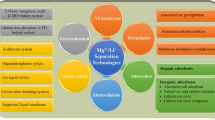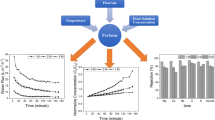Abstract
The consumption of lithium grows significantly on the global market, especially in Indonesia. To fulfill the demand, valuable lithium extraction from another natural source is considered, such as geothermal brine. During the research, the electrodialysis device was operated using different temperatures (30, 35, and 40 °C) and electric voltage (2 V, 3 V, and 4 V). The direct electric current was supplied by the electricity source, which comes from outside the membrane module. Due to the possible blockage on the membrane, synthetic geothermal brine was used in this study instead of nature-derived. Temperature and potential differences played essential roles in the concentration of lithium from the brine. The highest concentration is gained at temperature and electric voltage of 40 °C and 3 V, respectively.
Graphical Abstract













Similar content being viewed by others
References
Sumaatmadja N (1988) Studi Geografi Suatu Pendekatan dan Analisa Keruangan. Alumni, Bandung
Glasstone S, Sesonske A (1994) Nuclear reactor engineering. Engineering C. https://doi.org/10.1007/978-1-4615-2083-2
Opitz A, Badami P, Shen L et al (2017) Can Li-Ion batteries be the panacea for automotive applications? Renew Sustain Energy Rev 68:685–692. https://doi.org/10.1016/j.rser.2016.10.019
Murodjon S, Yu X, Li M et al (2020) Lithium recovery from brines including seawater, salt lake brine, underground water and geothermal water. Thermodyn Energy Eng. https://doi.org/10.5772/intechopen.90371
Flexer V, Baspineiro CF, Galli CI (2018) Lithium recovery from brines: a vital raw material for green energies with a potential environmental impact in its mining and processing. Sci Total Environ 639:1188–1204. https://doi.org/10.1016/j.scitotenv.2018.05.223
Hartono M, Astrayudha MA, Petrus HTBM et al (2017) Lithium recovery of spent lithium-ion battery using bioleaching from local sources microorganism. Rasayan J Chem 10:897–903. https://doi.org/10.7324/RJC.2017.1031767
Siekierka A, Tomaszewska B, Bryjak M (2018) Lithium capturing from geothermal water by hybrid capacitive deionization. Desalination 436:8–14. https://doi.org/10.1016/j.desal.2018.02.003
Grosjean C, Herrera Miranda P, Perrin M, Poggi P (2012) Assessment of world lithium resources and consequences of their geographic distribution on the expected development of the electric vehicle industry. Renew Sustain Energy Rev 16:1735–1744. https://doi.org/10.1016/j.rser.2011.11.023
Qurrahman AH, Wilopo W, Susanto SP, Petrus M (2021) Energy and exergy analysis of dieng geothermal power plant. Int J Technol 12:175–185. https://doi.org/10.14716/ijtech.v12i1.4218
Setiawan FA, Rahayuningsih E, Petrus HTBM et al (2019) Kinetics of silica precipitation in geothermal brine with seeds addition: minimizing silica scaling in a cold re-injection system. Geotherm Energy. https://doi.org/10.1186/s40517-019-0138-3
Tomaszewska B, Szczepański A (2014) Possibilities for the efficient utilisation of spent geothermal waters. Environ Sci Pollut Res 21:11409–11417. https://doi.org/10.1007/s11356-014-3076-4
Sutijan, Sujoto VSH, Mustika PCBW et al (2022) Lithium recovery with the membrane distillation method: a review. INSIST (in press)
Chen V, Li H, Li D et al (2006) Cleaning strategies for membrane fouled with protein mixtures. Desalination 200:198–200. https://doi.org/10.1016/j.desal.2006.03.294
Petrus HB, Li H, Chen V, Norazman N (2008) Enzymatic cleaning of ultrafiltration membranes fouled by protein mixture solutions. J Membr 325:783–792. https://doi.org/10.1016/j.memsci.2008.09.004
Mulder M (1996) Basic principles of membrane technology. Kluwer Academic Publishers, Dordrecht. https://doi.org/10.1007/978-94-009-1766
Nie X-Y, Sun S-Y, Sun Z et al (2017) Ion-fractionation of lithium ions from magnesium ions by electrodialysis using monovalent selective ion-exchange membranes. Desalination 403:128–135. https://doi.org/10.1016/j.desal.2016.05.010
Tanaka Y (2015) Electrodialysis. Prog Filtr Sep. https://doi.org/10.1016/B978-0-12-384746-1.00006-9
Chen Q-B, Ji Z-Y, Liu J et al (2018) Development of recovering lithium from brines by selective-electrodialysis: effect of coexisting cations on the migration of lithium. J Membr Sci 548:408–420. https://doi.org/10.1016/j.memsci.2017.11.040
Song Y, Zhao Z (2018) Recovery of lithium from spent lithium-ion batteries using precipitation and electrodialysis techniques. Sep Purif Technol 206:335–342. https://doi.org/10.1016/j.seppur.2018.06.022
Ji PY, Ji ZY, Chen QB et al (2018) Effect of coexisting ions on recovering lithium from high Mg2+/Li+ ratio brines by selective-electrodialysis. Sep Purif Technol 207:1–11. https://doi.org/10.1016/j.seppur.2018.06.012
Zhang Y, Wang L, Sun W et al (2020) Membrane technologies for Li+/Mg2+ separation from salt-lake brines and seawater: a comprehensive review. J Ind Eng Chem 81:7–23. https://doi.org/10.1016/j.jiec.2019.09.002
Hosseini SM, Gholami A, Madaeni SS et al (2012) Fabrication of (polyvinyl chloride/cellulose acetate) electrodialysis heterogeneous cation exchange membrane: characterization and performance in desalination process. Desalination 306:51–59. https://doi.org/10.1016/j.desal.2012.07.028
Kariduraganavar MY, Nagarale RK, Kittur AA, Kulkarni SS (2006) Ion-exchange membranes: preparative methods for electrodialysis and fuel cell applications. Desalination 197:225–246. https://doi.org/10.1016/j.desal.2006.01.019
Sata T (1994) Studies on ion exchange membranes with permselectivity for specific ions in electrodialysis. J Membr Sci 93:117–135. https://doi.org/10.1016/0376-7388(94)80001-4
Hoshino T (2015) Innovative lithium recovery technique from seawater by using world-first dialysis with a lithium ionic superconductor. Desalination 359:59–63. https://doi.org/10.1016/j.desal.2014.12.018
Antônio M, Rodrigues S (2014) Electrodialysis and water reuse. Springer, Berlin. https://doi.org/10.1007/978-3-642-40249-4
Murray P (1995) Electrodialysis and electrodialysis reversal—manual of water supply practices, m38 (1st edition). Am Water Work Assoc, Denver, pp 30–31
Zhao LM, Chen QB, Ji ZY et al (2018) Separating and recovering lithium from brines using selective-electrodialysis: sensitivity to temperature. Chem Eng Res Des 140:116–127. https://doi.org/10.1016/j.cherd.2018.10.009
Strathmann H (1995) Chapter 6: Electrodialysis and related processes. Membr Sci Technol 2:213–281. https://doi.org/10.1016/S0927-5193(06)80008-2
Melnikov S, Sheldeshov N, Zabolotsky V et al (2017) Pilot scale complex electrodialysis technology for processing a solution of lithium chloride containing organic solvents. Sep Purif Technol 189:74–81. https://doi.org/10.1016/j.seppur.2017.07.085
Mei Y, Tang CY (2018) Recent developments and future perspectives of reverse electrodialysis technology: A review. Desalination 425:156–174. https://doi.org/10.1016/j.desal.2017.10.021
Kleperis J, Linkov V (2012) Electrolysis. InTech, London. https://doi.org/10.5772/2820
Yan Z, Chen L, Wang H (2008) Hydrogen generation by glow discharge plasma electrolysis of ethanol solutions. J Phys D Appl Phys. https://doi.org/10.1088/0022-3727/41/15/155205
Mizuno T, Akimoto T, Ohmori T (2002) Confirmation of anomalous hydrogen generation by plasma electrolysis. In: Proc 4th Meet JCF, pp 1–34
Brodholt JP (1998) Molecular dynamics simulations of aqueous NaCl solutions at high pressures and temperatures. Chem Geol 151:11–19. https://doi.org/10.1016/S0009-2541(98)00066-7
Yamaguchi T, Ohzono H, Yamagami M et al (2010) Ion hydration in aqueous solutions of lithium chloride, nickel chloride, and caesium chloride in ambient to supercritical water. J Mol Liq 153:2–8. https://doi.org/10.1016/j.molliq.2009.10.012
Roy Y, Warsinger DM, Lienhard JH (2017) Effect of temperature on ion transport in nanofiltration membranes: diffusion, convection and electromigration. Desalination 420:241–257. https://doi.org/10.1016/j.desal.2017.07.020
Krol JJ, Wessling M, Strathmann H (1999) Chronopotentiometry and overlimiting ion transport through monopolar ion exchange membranes. J Membr Sci 162:155–164. https://doi.org/10.1016/S0376-7388(99)00134-9
Zabolotskii VI, Pis’Menskii VF, Demina OA, Novak L, (2013) Effect of concentration polarization on electrodialytic concentrating of dilute NaCl and NH4NO3 solutions. Russ J Electrochem 49:563–570. https://doi.org/10.1134/S1023193513060153
Baker RW (2011) Membrane technologies and applications. Membr Technol Appl. https://doi.org/10.1002/0470020393
Acknowledgements
The authors are grateful for the support of Gadjah Mada University and the collaboration of the Research and Development Division for Mineral Technology, Indonesian Institute of Sciences (LIPI) Lampung for the laboratory facilities used in the research
Funding
This study was financially supported by Ministry of Research, Technology and Higher Education of the Republic of Indonesia (RISTEKDIKTI) through Penelitian Dasar and support from the Research Unit for Mineral Technology, National Research and Innovation Agency (BRIN) Lampung.
Author information
Authors and Affiliations
Corresponding author
Ethics declarations
Conflict of interest
The authors declare that they have no conflict of interest.
Additional information
The contributing editor for this article was Hongmin Zhu.
Publisher's Note
Springer Nature remains neutral with regard to jurisdictional claims in published maps and institutional affiliations.
Rights and permissions
About this article
Cite this article
Sujoto, V.S.H., Sutijan, Astuti, W. et al. Effect of Operating Conditions on Lithium Recovery from Synthetic Geothermal Brine Using Electrodialysis Method. J. Sustain. Metall. 8, 274–287 (2022). https://doi.org/10.1007/s40831-021-00488-3
Received:
Accepted:
Published:
Issue Date:
DOI: https://doi.org/10.1007/s40831-021-00488-3




